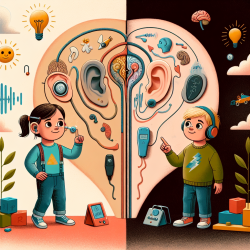Introduction
In the realm of speech-language pathology, the ability to make data-driven decisions is crucial. The study titled "Some experiments upon the recognition of speech, with one and with two ears" (Cherry, 1953) provides valuable insights into how practitioners can enhance their skills by understanding the benefits of bimodal hearing in children. This blog will explore the findings of this research and how they can be applied to improve outcomes for children with unilateral cochlear implants (CI) and contralateral hearing aids (HA).
The Study: Binaural Squelch and Head Shadow Effects
The research aimed to investigate the binaural squelch effect (BSE) and head shadow effect (HSE) in children using unilateral CI and contralateral HA. The study involved 19 children with severe-to-profound sensorineural hearing loss. The results revealed significant improvements in speech perception in noise when using bimodal listening, thanks to BSE and HSE.
Key findings included:
- An average BSE of 11.8% and HSE of 17.1% were observed.
- Significant differences in speech perception performance across three listening conditions.
- 13 out of 19 children benefited from BSE, while 17 showed improvements due to HSE.
Implications for Practitioners
For practitioners working with children who have unilateral CI and contralateral HA, these findings underscore the importance of considering bimodal hearing benefits. Here are some practical steps to implement these insights:
- Encourage Bimodal Use: Encourage children to use both CI and HA to maximize speech perception in noisy environments.
- Optimize Fitting: Work with audiologists to ensure optimal fitting of both devices, considering real-ear measurements and loudness balancing.
- Parental Counseling: Educate parents on the benefits of bimodal hearing to ensure consistent use of both devices by their children.
Encouraging Further Research
While this study provides valuable insights, further research is needed to explore the long-term benefits of bimodal hearing in children. Practitioners are encouraged to contribute to this growing body of knowledge by conducting their own studies and sharing findings with the community.
Conclusion
The study highlights the significant benefits of bimodal hearing in children with unilateral CI and contralateral HA. By leveraging these insights, practitioners can enhance speech perception outcomes for children, ultimately leading to better communication skills and academic success. To read the original research paper, please follow this link: Some experiments upon the recognition of speech, with one and with two ears.










